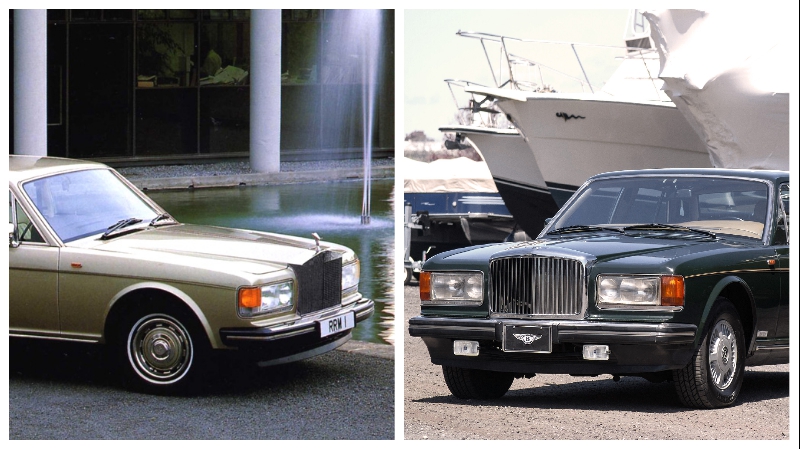The roll-out of final Bentley Mulsanne from Bentley’s Crewe factory recently represents more than just the end of a model. It also brings more than sixty years of Bentley’s shared history with Rolls-Royce to a close. A history that made the two names almost indistinguishable and inseparable.
Badge atop engineering

It isn’t just the technology and engineering that have come a long way in the automotive business. The art of “badge-engineering” have evolved past slapping on a different name and logo and calling it a day. Nowadays, most would relate it to a Volkswagen car or platform being repurposed by another Volkswagen Group brand. Or even a Hyundai and Kia arrangement with full body and interior reconstruction overlaying a shared chassis and drivetrain.
That isn’t to say that the old habit of passing off a new model with a remodelled front grille is no more. Looking at you Nissan and Renault. Companies today do put in far more effort into badge-engineering than they did fifty years ago. Case in point was the relationship between Bentley Motors and its owners, Rolls-Royce, from 1931 to 1998.

If you thought badge-engineering was done by budget manufacturers with tightened purse strings, Bentley and Rolls-Royce was the counterpoint. Though, despite being favoured by royalty and society’s elite, Rolls-Royce and Bentley weren’t exactly making bank for the better part of its 67-year history together.
Bentley and Rolls-Royce’s shared history

Under Rolls-Royce’s stewardship, the Bentley name continued its reputation of building luxury cars with a performance bent. From its first model under Rolls-Royce, the 1933 3½-litre, Bentley was responsible for the performance-oriented spinoffs of regular Rolls-Royce models.
Think of it as what AMG is to Mercedes-Benz, except with less bling and more turbocharging. However, for the proletariats of the era, telling a Rolls-Royce apart from its Bentley equivalent was nigh on impossible.

Describing Bentleys as cars for bankers with unions to crush and Rolls-Royce as cars for royal gentry with peasants to oppress doesn’t draw clearer definitions. Garnishing on the grille and the ornamental trinket on top aside, Bentleys and Rolls-Royces of the era were carbon copies in all but its tuning and setup.
For nearly seventy years the two brands weren’t just inseparable but nearly identical, conjoined even. However, the Rolls-Royce/Bentley relationship came to an abrupt halt in 1998.
Separated by mergers

As far as embarrassments go, the expose of the President of the United States diddling an intern was far from the biggest mess of 1998. That title belongs to Volkswagen. In 1998, Volkswagen won the bid for Rolls-Royce’s assets from aircraft manufacturer Vickers for a cool £430 million. Much to their chagrin, bidding rival BMW outmanoeuvred the giant for the rights to the Rolls-Royce name and logo. The name and logo was held by a different entity, Rolls-Royce Holdings. BMW paid out a reported £40 million to attain the rights to that.

With the split, BMW could terminate its engine supply deal for the Bentley Arnage/Rolls-Royce Silver Seraph with a year’s notice. Such an act would be suicide for a model that had just entered production. As such, the two companies had to strike a compromise. Volkswagen agreed to continue manufacturing the Silver Seraph for four more years, while BMW continued to supply its V12 and V8 engines for the Silver Seraph and its Arnage counterpart.

Wanting to draw itself away from BMW, Bentley pressed the venerable 6.75-litre twin-turbocharged pushrod V8 from the Mulsanne-based Turbo R into the Arnage’s service for the 1999 model, just a year into its production run. By then the 6.75-litre L-Series engine, or more affectionately known as the “six-and-three-quarter”, was a 40-year old relic. Though, that wasn’t a bad thing, as the old guard made a gargantuan 313kW/875Nm, outgunning the BMW-supplied 260kW/570Nm V8.
“L” for longevity

The L-Series engine first made its debut in the 1959 Bentley S2/Rolls-Royce Silver Cloud II. Hailed for its smoothness, size, and lightness over Rolls-Royce’s 4.9-litre inline-six, the V8 became a fixture in the Bentley/Rolls-Royce line-up. From a humble 6.2-litre mill with just 128kW, the engine has been tweaked and internals replaced over six decades into becoming the monstrous 395kW/1100Nm “six-and-three-quarter” twin-turbo titan in today’s Bentley Mulsanne Speed.

Though anachronistic and alone in Volkswagen’s world of shared engines, the “six-and-three-quarter” would find its final home in the Mulsanne. Aside from its engine, the Mulsanne shared nothing with Rolls-Royce or Volkswagen, making it the first “pure Bentley” in eighty years. Even as a 21st-century flagship, the utilisation of the L-Series engine is a fitting link to its illustrious past. A link that many pundits knew wouldn’t last in this day and age of limiting emissions.
End of an era

Unsurprisingly, Bentley wrapped up a decade of the Mulsanne’s production and sixty years of the L-Series just last month with the final 6.75 Edition models. If it is any consolidation for the big odd-faced giant, Bentley has no plans to replace it. With the Bentayga SUV filling their order books and the Flying Spur doing a fine job as a limousine already, the Mulsanne can bow out in grace, ending a near ninety-year-old link to its luxurious counterpart. Thus, bringing one of the longest and most iconic “badge-engineering” relationships in the industry to a close.

